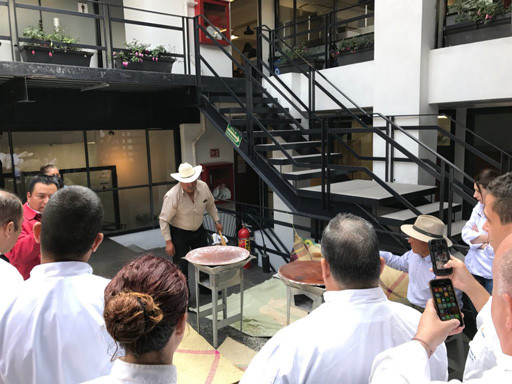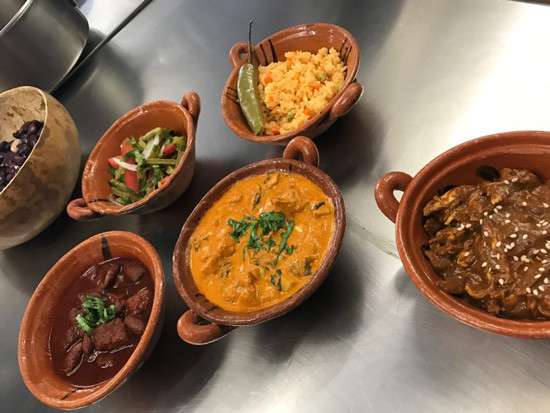Trendspotting in Mexico – Are You Ready to Ride the Next Wave of the Mexican Food Trend?
When it comes to learning something truly authentic about food, you have to cross oceans and borders

If we believe food-trend researchers and chefs, Mexico has caught up with Peru – speaking in culinary terms, of course. That is why it is hardly a coincidence that the LSG Sky Chefs’ Latin American Culinary Leadership team chose to hold their latest regional workshop in Mexico City. Rumor has it that Mexican cuisine is about to steal the culinary crown from Peru, which has grown to be known as a source of excellent haute cuisine (think Ceviche, Ají de Gallina and others). I was able to participate in the workshop along with my colleagues from Latin America.

The incredible complexity of Mexican cuisine makes my chef’s heart beat faster. Knowing guacamole and tacos, some may be tempted to think that Mexican dishes are quickly prepared. But don’t be fooled, the Mexican cuisine that is popularly known outside the country represents just a fraction of what there is to taste. Guacamole is just the tip of the food-berg, so to speak.Unlike the cuisine in other countries of the Americas, Mexican cuisine is still based on ancient culinary practices that have been passed on over many generations – one of the reasons why it was recognized as Intangible Cultural Heritage of Humanity by UNESCO. These food practices include unique farming methods, ingredients native to Mexico, such as cocoa, amaranth, ñame, yuca and you guessed it, spicy chiles, plus a wealth of cooking processes involving the participation of entire communities, strengthening both local and national identity.
Now that another wave of Mexican cuisine has reached culinary hotspots and the kitchens of celebrity chefs, traditional cooking methods are amalgamated with a contemporary approach to Mexican food, resulting in new interpretations of traditional recipes. But in order to learn, it’s necessary to go back to the roots.
Lots to learn in Mexico
LSG Sky Chef employs people in more than 52 countries and takes pride in the regional and local culinary expertise of its chefs. But given the culinary wealth of this planet, there is always a lot more to learn about local cuisine(s). The Latin America Culinary Excellence Leadership team, which spearheads culinary development and innovation in this region, attended a three-day workshop to sharpen their expertise in Mexican cuisine at the University of the Cloister of Sor Juana – with the next big Mexican food trend in the back of their minds. Many of us worked in high-class restaurants around the world before joining the airline-catering business and all are excellent chefs. But there is always something new to learn. And when top chefs learn, they want to learn from those who know best. The different workshops were, among others, taught by amaranth producers and families who have been passing on cooking methods over decades, if not centuries. During the workshops, we were able to get our hands-on-experience with the different techniques and ingredients that were being used, whether it was the grinding of chiles, amaranth popping or preparing mole. I got my fair share of popping amaranth, and trust me it is not as easy as it looks!
Mole: The royal discipline
Avocado-based guacamole has reached worldwide popularity and is an example of how Mexican foods have become incorporated in foreign cuisines. The term mole itself, though best known in its mole poblano and mole negro forms, which contains chilies and chocolate, stands for a much more complex set of sauces that are inherent to Mexican regional cuisine. It is representative of the complexity of this cuisine because there are endless ways of preparing them, depending on the region, household and ingredients.

The complexity of a mole begins with the hour-long individual preparation of each of the thirty or more ingredients and ends with a taste experience that leaves any sauce hollandaise seeming bleak. The effort involved in the preparation is definitely reflected in the taste of this dish. And although I often praise simple yet tasty dishes, I assure you that mole is all worth the effort.
What did I learned from this workshop? For some, cooking is a profession or a means to eating. In reality, it is a lifelong learning experience. I highly appreciate that we were able to learn so much about Mexican cuisine from these highly skilled people who have been safeguarding their culinary traditions over generations. One thing is clear: There is always more to learn in the realm of food, and you have to cross oceans and borders to do so.
Culinary Regards,
Jörg Tüttelmann